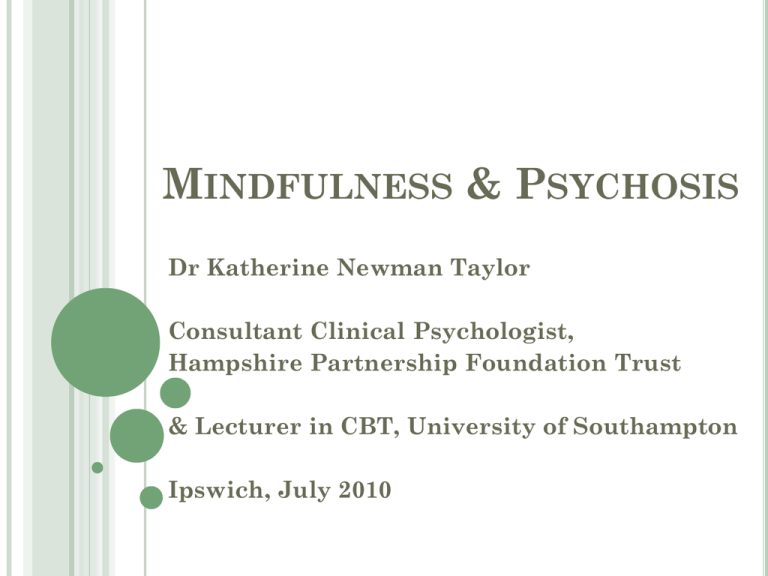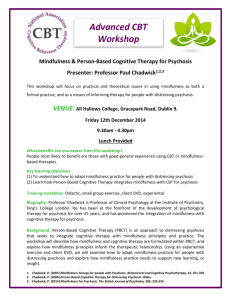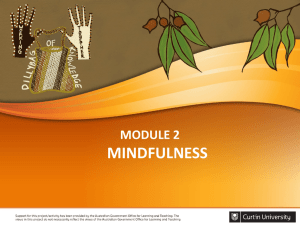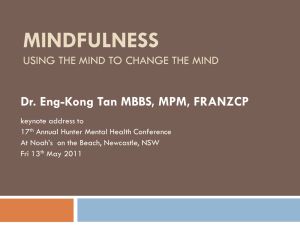K Newman-Taylor Minfdulness with psychosis - Ipswich
advertisement

MINDFULNESS & PSYCHOSIS Dr Katherine Newman Taylor Consultant Clinical Psychologist, Hampshire Partnership Foundation Trust & Lecturer in CBT, University of Southampton Ipswich, July 2010 Getting started Evidence; outcome & process Experiential exercise What is mindfulness? Mindfulness for psychosis Why mindfulness with psychosis? Why not? Model & implications for practice WHAT IS MINDFULNESS? Origins in Buddhism Psychological practice that can sit outside Buddhism Based on premise that distress is exacerbated and maintained by our reactions to experience Kabat Zinn (1990) ‘Paying attention in a particular way to what is happening right now, in the present moment, non-judgementally.’ Teasdale, Williams and colleagues (eg 2000) To ‘decentre’ or ‘step back’ and learn to observe thoughts as events in the mind rather than necessarily accurate reflections of self or reality WHY MINDFULNESS WITH PSYCHOSIS? Limitations of medication for many people Research indicates that certain types of cognitive reaction (suppression, rumination, confrontation) are associated with increased distress in relation to psychotic symptoms Recognition that relationship with experience, as well as content, is key in cognitive therapy Mindfulness rationale is consistent with clinical observation that people learn to live with voices and paranoia when their relationship with these internal experiences changes WHY NOT? Literature for mindfulness / meditation with psychosis is limited and generally cautionary (Deatherage & Lethbridge, 1975; Yorston, 2001) Individuals with psychosis are often deemed vulnerable, with concerns that the practice may increase distress to become overwhelming The question posed by this literature is: How can mindfulness safely and therapeutically be introduced to people with psychosis? HOW DO WE REACT CHADWICK (2006) TO PSYCHOTIC SENSATIONS? MINDFULNESS PRACTICE FOR PSYCHOSIS Therapists practice mindfulness with service users Ground awareness in the body with brief body scan Anchor awareness in breathing Invited to ‘turn toward’ sensations that enter awareness Note and ‘let go’ of reactions eg avoidance, struggle, rumination, judgement MINDFULNESS PRACTICE FOR PSYCHOSIS Brief guidance or comments frequently – an important grounding method Length of practice limited to 10 minutes rather than the traditional 20-45 minutes People encouraged to close eyes to reduce sensory stimulation if happy to do so Reflective discussion key to learning after the practice Usually two practices per session Experiential exercise MINDFULNESS ISN’T Relaxation Distraction Passive Getting rid of experience About feeling good ... EVIDENCE: OUTCOME Chadwick, P., Newman Taylor, K & Abba, N (2005) Mindfulness groups for people with psychosis. Behavioural & Cognitive Psychotherapy, 33, 351-359 Pilot study of 10 people with distressing psychosis Taught mindfulness of the breath Significant improvement in mindfulness skills & reduction in CORE Newman Taylor, K., Chadwick, P. & Harper, S. (2009) The impact of mindfulness on affect and meaning in psychosis. Behavioural and Cognitive Psychotherapy, ..... Two case studies, tracking change over time Taught mindfulness of the breath Reduction in distress associated with voices & belief conviction EVIDENCE: OUTCOME distress of voices belief conviction Participant A 9 8 7 6 5 4 3 2 1 week 18 17 16 15 14 13 12 11 10 9 8 7 6 5 4 3 2 1 0 0 distress and belief conviction 10 EVIDENCE: OUTCOME distress of voices belief conviction Participant B 9 8 7 6 5 4 3 2 1 week 18 17 16 15 14 13 12 11 10 9 8 7 6 5 4 3 2 1 0 0 distress and belief conviction 10 EVIDENCE: PROCESS Abba. N., Chadwick, P., & Stevenson, C. (2008) Responding mindfully to psychosis: A grounded theory analysis. Psychotherapy Research, 18(1), 77-87 Used Grounded Theory to investigate the psychological processes involved in responding mindfully to unpleasant psychotic sensations – voices, thoughts and images Grounded Theory chosen because, as well as providing a rich description of participants’ experience, it produces a theory of the phenomenon under study – what is actually going on 16 people with current distressing psychosis interviewed after completion of a mindfulness group programme FINDINGS - CORE PROCESS Experiencing how to relate differently to psychosis Centering in awareness of voices, thoughts, images in the moment Opening awareness to include the unpleasant Anchoring awareness in breath and body Concentrating gently on what is present Beginning again and again Not trying too hard Reconnecting with present experience Allowing voices, thoughts, images to come and go without reacting/struggle Letting go of judgment, fight, worry, analysis Catching myself in habitual reactions Relaxing into a peaceful,calm state Seeing my role in alleviating distress Recognizing consequences of reacting Realizing emotional consequences of letting go of habitual reactions Reclaiming power through acceptance Accepting voices, thoughts, images Feeling more in control of my mind Deflating psychosis Accepting myself Knowing I am more than my psychosis Discovering that I am not different CONCLUSIONS Key problem for people with psychosis is a distressing and tyrannical relationship with psychosis People are attempting to manage and resolve this tyrannical relationship Mindfulness is not a cure for psychosis – psychotic sensations remain but with support, people can learn to respond differently to them Acceptance of psychotic sensations and self supported by ‘metacognitive insight’ – developed through direct practice and reflection GETTING STARTED Personal practice CDs – eg Williams, Kabat-Zinn Join a mindfulness group – as participant, co-facilitator Talk to others – psychologist? – about starting a group Reading SUMMARY Emerging evidence that mindfulness can be useful for people with psychosis Relationship with experience is key Rationale for using Mindfulness with any given person needs to be incorporated into individual formulation and can be one component of a CBT intervention Personal practice is the starting point!





